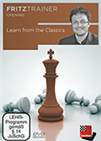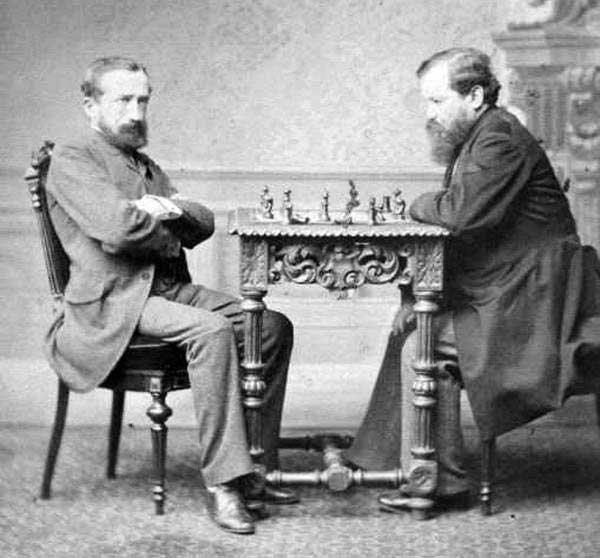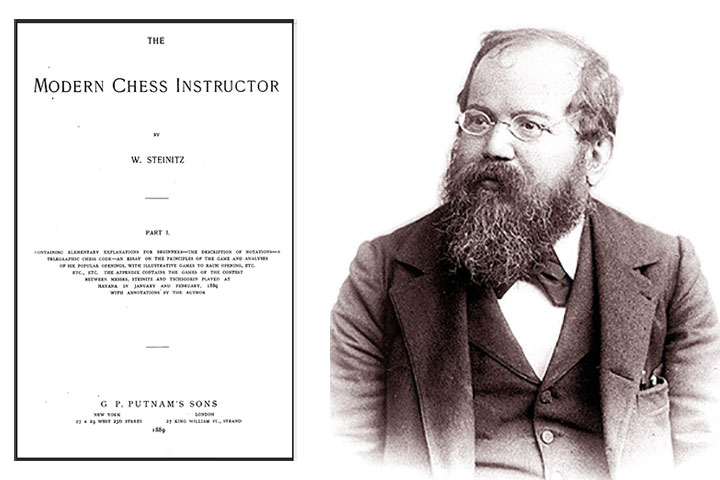Discovering the "Modern School"
As I pointed out in my article Romantic Steinitz, Steinitz became the No. 1 in chess, although (or because?) he practiced the romantic playing style; he was extremely successfully with gambits, king attacks and spectacular sacrifices. When he moved to London in 1862, he met many position players there who were probably strongly influenced by Howard Staunton (1810 - 1874). This English grandmaster was a very cautious player. He usually sacrificed a piece only when he could clearly predict the outcome. His books The Chess Player's Handbook, The Chess Player's Companion and Chess Praxis were widespread in England at that time. His booklet The Chess Player's Textbook was even given free of charge to anyone who bought a set of Staunton chess pieces. World Champion Dr. Emanuel Lasker described in his Lehrbuch des Schachspiels what happened in England at that time:
 Sagar Shah shows you on this DVD how you can use typical patterns used by the Master of the past in your own games. From opening play to middlegame themes.
Sagar Shah shows you on this DVD how you can use typical patterns used by the Master of the past in your own games. From opening play to middlegame themes.
The English chess friends especially liked the stormy nature of the master who had grown up in the German school of combination, because they could learn a lot from Steinitz, just as Steinitz could learn from them. From the contact of the two fundamentally different temperaments, the imaginative, daring one of the combination of Anderssen with the far-sighted, planned one of the position play of the English, a synthesis arose in Steinitz, which was destined to make history. (a)

Zukertort vs. Steinitz during the first World Championship (1886)
When Steinitz subjected his games, played until about 1872, to a critical analysis, he found that in many cases mistakes of the defender had led to defeat, and that with correct defence the unconditional gambit style would be doomed to failure. For this reason, he increasingly tried to succeed by a more cautious approach. The first test run for this new strategy was the tournament in Vienna in 1873, which he won after a successful playoff against the great English combinative player Joseph Henry Blackburne. Since that time there has also been a change in William Steinitz's opening repertoire. Until then, the King's Gambit, the Vienna game with an early f4 and the Evans Gambit were his preferred openings when he had the white pieces, but in his later years Steinitz increasingly played the Giuco Piano, the Ruy Lopez and the Queen's Gambit. Steinitz called his new concept the "Modern School". What did Steinitz actually mean by that term and what did he think of chess in general? Let's ask him!

Steinitz memorial plate in Prague | Photo: Ken Whyld Association
Steinitz on chess, his theory and how to improve
(The questions of the following "virtual" interview come from me and the answers from William Steinitz himself, as he published them in his book The modern Chess Instructor in 1889.)
S.O.P.: Mr. Steinitz, first of all, thank you very much for agreeing to answer a few questions for our readers. In your opinion, what is the main difference between chess and other games?
William Steinitz: The practice of our noble pastime is in no way influenced by any element of chance, excepting that of temporary individual dispositions, which after all forms a most important element of strength, and the results of chess contests are therefore strictly based on a scientific and logical foundation. Both parties are placed on a perfectly equal
footing on starting, as regards the forces and their respective powers, and the same rules regulate the movements or actions of the combatants. It is, therefore, purely a battle of the reasoning qualities that decides the issue in a game of chess, and the infinite variety of possible combinations in playing the game afford the widest scope for the exercise, and, therefore, the training of the logical as well of the imaginative faculties of mind.
Is chess just a game or does it have other benefits? Why should you play chess or in other words: What do you derive from it?
WS: In our time the game of chess is becoming more widely popular among intelligent people in different countries, and it is almost universally recognized as a healthy mental exercise, which in its effects on the intellectual faculties is akin to that of physical gymnastics on the conservation and development of bodily strength. Moreover, the cultivation of the game seems also to exercise a direct influence on the physical condition of chess players and the prolongation of their lives, for most of the celebrated chess masters and authors on the game have reached a very old age, and have preserved their mental powers unimpaired in some instances up to their very last moments. This can be no mere coincidence.
What do you think is the reason for this?
Once a chess player becomes initiated in the elements of the game he derives an extraordinary amount of entertainment and pleasure from pursuing it, and a healthy spirit of emulation stimulates his ambition to become proficient in the noble pastime. He is then sure to learn by experience that any habits that are injurious to general health will also greatly disturb his capacity to do his best and to improve as a player, and that modes of living that are detrimental to a sound condition of body must be rigorously checked or else his play deteriorates. On the old maxim, "mens sana in corpora sana," ["a healthy mind in a healthy body" -Ed.] it may therefore reasonably be assumed that as a general rule, with very few exceptions, ardent devotees of the game will be intelligent people, who are possessed of healthy organizations, and as the practice of our pastime is conducive to habits that are beneficial to the preservation of good health, it will also greatly influence the prolongation of life.
Let us now look at the "Modern School" that you promoted. What fundamental considerations did you base your findings on?
The object of the game is to checkmate the adverse king as early as possible, and the whole play of each party has to be made subservient to that end. Theorists and practical experts have naturally attempted to effect this purpose, or at any rate to gain some material advantage by a direct attack against the hostile king in the opening, and in numerous instances they have succeeded in proving that pawns and pieces may be given up very early in the game for the purpose of harassing the adverse king and with the effect of accomplishing the mate, or at least of recovering material greater in value than what had been temporarily sacrificed. Generally such attacks are essayed in practice by the first player, or advocated in analysis for the same party, and it was always admitted that the second player cannot obtain such opportunities in the opening excepting when a fault is committed by the adversary. But later researches and practical trials among masters have proved that such sacrifices early in the game, even of the first party, are mostly unsound or else they succeed only in consequence of moves on the other side which can be demonstrated as errors of development.
If both opponents avoid such errors of development and play flawlessly throughout the game, what will happen then?
In fact it is now conceded by all experts that by proper play on both sides the legitimate issue of a game ought to be a draw, and that the right of making the first move might secure that issue, but is not worth the value of a pawn. It therefore follows, that theoretically as well as practically, among first-class masters of equal strength, not a single pawn can be given up by either party at any stage of the game without at least, greatly endangering the result, unless it can be soon recovered. But, moreover, it has been proven beyond any doubt that, irrespective of an attack against the adverse king, the mere weakness of any square on any part of the board will cause great inconvenience and trouble and very often will be fatal. In the middle of the game such points will generally be occupied by a hostile piece that will exercise a menacing attitude, and will be extremely difficult to dislodge, which often gives the adversary time to strengthen his position, either by bringing more of his forces to bear on such a point or by obtaining greater freedom for his other pieces for the formation of an attack in another direction.
If I understand that correctly, not only cannot you give up a single pawn without jeopardizing the game, but you mustn't even let your opponent take over a single weak square?
A game will generally be lost when such a vantage ground can be taken by the opponent on the king's side or in the centre before the exchange of several pieces have been effected, but such weak squares are also dangerous in the ending after the exchange of queens and rooks, and when the kings are brought into play, for it is then mostly important to gain moves with the pawns, and the side that is free from weak points will have a great advantage for that purpose.
In what other respects does your modern school differ from the teachings of the old masters?
It is especially as regards the powers of the king that the modern school deviates from the teachings and practice of old theorists and chess masters, and we consider it established that the King must be treated as a strong piece both for attack and defence. This means that so far from the King requiring great protection early in the game a few simple precautions will render him so safe that any attempt at attacking his wing will be more dangerous for the opponent than for himself.
Why do you think that the king's attack is more dangerous for the attacker than for the one who is attacked?
Such attacks can only be formed either by advancing pawns on that wing, in which case those pawns become weak for the ending, if the attack fails; or else by directing several pieces against the adverse King and thus deploying them for defensive action on some other point of the board where the opponent may break in with superior forces. But, moreover, several forms of openings have been developed in which the king, though apparently on the defensive for some time, is brought into action early in the game, and after withstanding a seemingly vehement attack, obtains perfect security with the superior position generally for the ending, by means of forcing the exchange of heavy pieces after having gained some advantage in material, but sometimes also in the middle game, with nearly all the principal forces of both parties on the board.
So how do you think you should develop your game, or in other words: What strategy should you adopt to be successful in chess?
The very treatment that is now advocated as the classical one by best play on both sides consists in a steady development without any sacrifice of material, circumspective attention to the balance of forces and of position on all parts of the board, and the accumulation of small advantages if possible. The principal thesis of the modern school may be briefly summarised thus: Among first-class masters the capture of the adverse king is the ultimate but not the first object of the game and by best play on both sides a draw ought to be the legitimate result.
What do you say to your critics who accuse you of reducing the number of King's attacks and thus reducing the number of brilliant combinations due to your modern school?
This is a sort of sentimental objection that ought to exercise but very little influence on our game which is essentially of a scientific character. We entirely agree with Baron von Heydebrand und der Lasa who lays down the sound maxim: "The simplest and the shortest way of winning is the best." Correctness of judgment and calculation ought to be chiefly cultivated in the exercise of our pastime, and it merely shows primitive taste to prefer brilliancy to soundness. Elegance of style when opportunity arises is no doubt an attribute of a great master, but the fact should never be lost sight of that the brilliant sacrificing combinations can only occur when either side has committed some grave error of judgment in the disposition of his forces, and therefore, only very rarely in important games between first-class masters.
What would you recommend to young, aspiring players who have the ambition to improve?
In the first place, a learner should seek as much as possible to play on even terms with superior players. A very important point is always to observe strictly the law of "touch and move." But the temptation to take back a move is very great with a beginner. Regularity of study and practice very much facilitates making rapid progress. The player by fits and starts will scarcely ever improve and it is much better to devote to chess one hour per day for six consecutive days than six hours one day in the week. In order to strengthen the powers of chess perception and memory, a good habit to cultivate is that of playing over from recollection one's own games, or more especially selected and well annotated published games played by masters. The study of problems is extremely useful for the purpose of developing and increasing strength in practical play. It is especially the faculty of precision which has to be exercised absolutely in the study of problems, whereas in the game the winning process may often be effected in many different ways. (b)
How Steinitz applied his theory
As an illustration of how Steinitz applied his theory in practice, let's examine two games. James Mason vs. William Steinitz (London 1899) shows very beautifully how weak squares are created and how small advantages are accumulated until a huge superiority is obtained.
In his game against Blackburne, which was played in the play-off for the first prize of the Vienna Tournament in 1873, Steinitz confused his opponent by opening with "1.a3". Blackburne did not find any suitable counter strategy and lost quickly.
If you want to take a closer look at the games of Steinitz played, check the ChessBase Mega Database. It contains about 780 games played by him, many of them annotated.
The ChessBase Mega Database 2020 is the premiere chess database with over eight million games from 1560 to 2019 in high quality. Packing more than 85,000 annotated games, Mega 2020 contains the world‘s largest collection of high-class analysed games. Train like a pro! Prepare for your opponents with ChessBase and the Mega Database 2020. Let grandmasters explain how to best handle your favorite variations, improve your repertoire and much more.
References
(a) Emanuel Lasker, "Lehrbuch des Schachspiels", 4th edition, Hamburg 1977, p. 171 (Translation by S. O. Platz)
(b) William Steinitz's answers are excerpts from his book "The Modern Chess Instructor", New York and London 1889, p. XXVII – XXXIII.

























